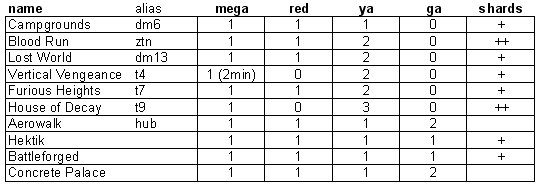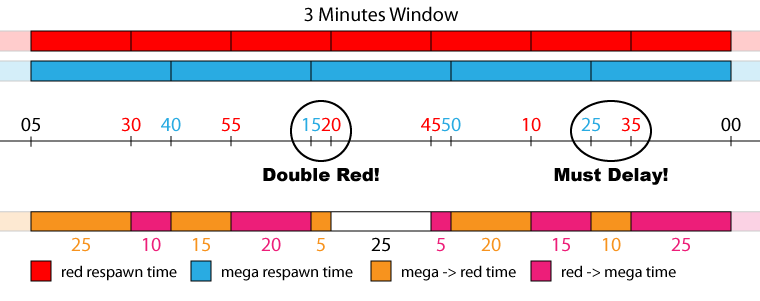In this section I would like to propose a few rules to help you with timing. I d-tour a bit from the pure item timing in the classic sense in favor of a bit of contextualization.
4. Which items do I time?
In any real time game, concentration is a resource. If a particular task requires too much concentration, other tasks will be executed worse. It is therefore important to reduce the amount of concentration that timing requires. Practicing the timing table can avoid you the hassle of actually computing numbers, but thatís not the only thing you can do. An other important aspect of timing is to chose what items you want to time.
4.1 The roles

a '+' idicates the equivalent of ~25ap in shards
Let's consider the items available on duel maps. A simple - but hopefully not simplistic - way of thinking is to partition the items into the strong (200+) and weak (100+) stacks, mega and red on one side, yellows and ga on the other. According to this view, we define the player in control as the one that runs the strong stack, and the player out of control as the one running the weak stack.
Timing every item is very hard, sometimes impossible, and you also have to consider your own ability, which may limit the number of items you can time down to one or two. To start simple, you can consider what role you are playing at a given time. The role defines the actions you do, and these actions requires you to put more emphasis on certain items than others.
Being able to pick a few items that are important to you at a give time allows you to spend your concentration doing other things well, overall improving your game. Of course the more raw timing power you have, the more items you can time for the same amount of concentration, so - again - train the timing table.
4.2 The Actions
Actions while in control
Actions while out of control
Additional actions
Both roles require you to time about 2+ items, and have advantages and disadvantages. Speaking of pure timing, there are two aspects to consider: traveling options and timing complexity.
4.3. Traveling options
5. Timing your actions
Timing is not just about timing the items, but also about timing actions. To the bare minimum, you need to have enough time to go and pickup an item when it spawns. But actually there is much more. Remember the discussion about having a plan? Thatís what timing your action is about: building a good plan within the time constraints of the situation.
The first skill to master is to time your own actions. What follows are a few suggestions.
5.1. The Five Seconds rule
This is a basic rule some people may find useful. 5 seconds is a good estimate of the time it takes to go from anywhere to anywhere else in a duel map. This means that most of the actions, like grabbing a weapon, replenish your health, collect an item, etc. will take at most 5 seconds. Of course, this shouldnít stop you from practicing specific actions in specific maps to see how fast you can be.
In general, however, 5 seconds is good number:
Let us recall the actions listed in section 4.2. At any point in the game, you must decide what to do next, i.e. you have to fill in your plan. To be successful you need be able to make a good plan for every possible situation. Studying the available options in advance is a key to speed up the process, although it is not a substitute for real practice.
A simple thing to do when you are playing is to apply the 5 seconds rule, subtracting 5 seconds to the time you have before the next item spawn. To exemplify:
The problem with red and mega is quite a unique simple situation, but yet if you fail at recognizing it you will have some problems.
The situation is: if you take the red after 10 seconds the mega was taken, the next spawn will be in sync. Taking red after 5- seconds is ok, after 15+ is ok, but around 10 is really wrong.
5.3. The Double Red rule
Once in control, you usually pick both red and mega. They alternate well until a specific moment. There is a simple rule, similar to the one for the delay, that should allow you to solve this problem.
If you take red 5- seconds after mega, there will be a second red before the next mega.
Both rules are shown in the chart below.

4. Which items do I time?
In any real time game, concentration is a resource. If a particular task requires too much concentration, other tasks will be executed worse. It is therefore important to reduce the amount of concentration that timing requires. Practicing the timing table can avoid you the hassle of actually computing numbers, but thatís not the only thing you can do. An other important aspect of timing is to chose what items you want to time.
4.1 The roles
a '+' idicates the equivalent of ~25ap in shards
Let's consider the items available on duel maps. A simple - but hopefully not simplistic - way of thinking is to partition the items into the strong (200+) and weak (100+) stacks, mega and red on one side, yellows and ga on the other. According to this view, we define the player in control as the one that runs the strong stack, and the player out of control as the one running the weak stack.
Timing every item is very hard, sometimes impossible, and you also have to consider your own ability, which may limit the number of items you can time down to one or two. To start simple, you can consider what role you are playing at a given time. The role defines the actions you do, and these actions requires you to put more emphasis on certain items than others.
Being able to pick a few items that are important to you at a give time allows you to spend your concentration doing other things well, overall improving your game. Of course the more raw timing power you have, the more items you can time for the same amount of concentration, so - again - train the timing table.
4.2 The Actions
Actions while in control
- Collecting the major items
- Steal some of the minor items from the opponent, to keep his stack and options low
- Chase the weaker opponent to score points
Actions while out of control
- Stack up with minor items up to a decent amount (100 100+)
- Spam major items to reduce the opponents advantage
- Steal major items when the opponent does a mistake
Additional actions
- Set up traps
- Delay the opponent
Both roles require you to time about 2+ items, and have advantages and disadvantages. Speaking of pure timing, there are two aspects to consider: traveling options and timing complexity.
4.3. Traveling options
- the player in control has the advantage that he knows he can engage the enemy in most situations. Even if he eats a full rocket, he usually still has stack advantage to bring a frag to the score board and fall back to a major item to replenish. The effect is that he can chose all sorts of paths throughout the map and bully the opponent at his will.4.4. Timing Complexity
- In contrast, the player out of control will have to chose his routes carefully, avoiding to engage even fights, and always having an escape plan. This forces him to be slower and only stay in safer areas of the map. In turn, this may result in the impossibility of taking all ya/ga or see/spam the major item pickups
- Timing mega and red is more complex due to the changing order of the pickups. Avoiding the sync requires a bit of practice (see below), and any mistake opens the chance for the opponent to steal your precious.
- The player out of control has to time mainly armors. These are easier to time as the order does not change. Sometimes one can even time only one armor and know that the rest of armors and shards follow a particular cycle.
5. Timing your actions
Timing is not just about timing the items, but also about timing actions. To the bare minimum, you need to have enough time to go and pickup an item when it spawns. But actually there is much more. Remember the discussion about having a plan? Thatís what timing your action is about: building a good plan within the time constraints of the situation.
The first skill to master is to time your own actions. What follows are a few suggestions.
5.1. The Five Seconds rule
This is a basic rule some people may find useful. 5 seconds is a good estimate of the time it takes to go from anywhere to anywhere else in a duel map. This means that most of the actions, like grabbing a weapon, replenish your health, collect an item, etc. will take at most 5 seconds. Of course, this shouldnít stop you from practicing specific actions in specific maps to see how fast you can be.
In general, however, 5 seconds is good number:
1) Because even if you may be faster, unexpected events may slow you down a bit.
2) Because itís easy to add/subtract to the clock
3) Because itís half the difference between armor/mega re-spawn (see later)
Let us recall the actions listed in section 4.2. At any point in the game, you must decide what to do next, i.e. you have to fill in your plan. To be successful you need be able to make a good plan for every possible situation. Studying the available options in advance is a key to speed up the process, although it is not a substitute for real practice.
A simple thing to do when you are playing is to apply the 5 seconds rule, subtracting 5 seconds to the time you have before the next item spawn. To exemplify:
- If you have 15+ seconds before the next major item, you can devote 10+ seconds to some meaningful action, like try and steal a ya, setup a trap, or chase a running enemy.5.2. The Delay rule
- If you only have 7- seconds before the next major items, you can take your time to carefully go to the proper position (potentially avoiding traps), or you can deviate a bit to grab ammo or so, but there is little more you can do if you want to secure the item to you.
The problem with red and mega is quite a unique simple situation, but yet if you fail at recognizing it you will have some problems.
The situation is: if you take the red after 10 seconds the mega was taken, the next spawn will be in sync. Taking red after 5- seconds is ok, after 15+ is ok, but around 10 is really wrong.
5.3. The Double Red rule
Once in control, you usually pick both red and mega. They alternate well until a specific moment. There is a simple rule, similar to the one for the delay, that should allow you to solve this problem.
If you take red 5- seconds after mega, there will be a second red before the next mega.
Both rules are shown in the chart below.


